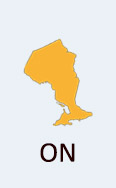| TRAINEE LOGIN | | | EMPLOYER / BILLING LOGIN | | | CONTACT US |
Manitoba WHMIS Training and Certification
The Workplace Hazardous Materials Information System (WHMIS) is Canada’s adaptation of the Globally Harmonized System of Classification and Labeling of Chemicals (GHS) created by the United Nations. Canada was one of many nations who adopted the GHS and endeavours to enact its principles and standards across our country. In Canada, WHMIS is implemented in accordance with federal legislation as laid out by Hazardous Products Act and the Controlled Products Regulations.
These federal components are handed down to the provinces to be enforced so that persons would not be subjected to investigators from both federal and provincial jurisdictions. In Manitoba, WHMIS is covered under Manitoba Labour and Immigration, in the Workplace Safety and Health Act and Workplace Health and Safety Regulation, M.R. 217/2006, Part 35. The number one way Manitoba Workplace Safety and Health ensures WHMIS compliance is by making sure employers provide education to their employees about all aspects of WHMIS.
WHMIS is made up of pictographs, hazard classifications, and a system for labeling that must be applied to dangerous chemicals and hazardous materials found in the workplace.
As an employer in MB, do I need to educate and train my employees on WHMIS?
The simple answer to this question is Yes. Any employee who encounters hazardous materials, or handles them as part of manufacturing, must receive training on WHMIS. Where controlled products are present in the workplace, there needs to also be proof of correct product labeling and visible Safety Data Sheets (SDSs) that outline what the chemicals present are, their risks, emergency protocols, and other.
If a local committee or initiative exists, employers need to connect with Workplace Safety and Health and work with a committee representative. Training must always be as workplace specific as possible and should result in an employee retaining sufficient knowledge about labeling, pictographs, SDSs, classifications, and emergency procedures.
Employers must also train workers to protect themselves if they are exposed to emissions from a process at the workplace and train them how to handle hazardous waste produced within the workplace. Training should also cover precautions to be taken in case of an emergency such as a spill or fire.
In many cases, “Generic WHMIS” training is acceptable, but in workplaces where employees encounter specific materials, more job-specific training is required to protect that employee and the general public. Some employers add this as a part of an overall workplace health and safety program and appoint a delegate to maintain their WHMIS program. This often fits well into a regular job description in the Human Resources department.
Education on WHMIS is often outsourced so that the employer knows the right information is being covered. Credible WHMIS education providers will review hazards classifications, how to read SDSs and labels, what emergency protocols go with which substances, and more.
Employers also need to ensure the workplace is compliant with WHMIS in each and every hazardous product they bring in. All products need to be labeled with the current WHMIS standard in labeling, which includes pictographs displaying warnings in non-written language, hazard classification, and even emergency protocol instructions, in some cases. If a label on a product becomes damaged to the point of illegibility, ripped off or lost, the employer must ensure that the product containers are relabeled before employees can be in contact with them. This also includes any products that may have been imported without labeling.
A safe workplace, compliant with WHMIS, also means providing employees with personal protective equipment and any other necessary equipment to help protect employees as much as possible from regular exposure to dangerous chemicals.
How frequently do I need to train my workers on WHMIS in MB?
In MB, WHMIS must be reviewed or renewed annually, or more frequently in the case of any product or handling information updates. Making sure new workers are trained on WHMIS in a timely manner after their start date means keeping WHMIS top of mind more than just once in the year. And if products, equipment, or job duties change, up to date training needs to be provided. Evaluating what training may be needed during transition, as well as evaluating all worker education and competencies annual is important.
An integral part of training is evaluation and after each WHMIS course, a test should be administered to determine if the employee has retained the information.
Do I need to have a WHMIS Certificate for my employees?
It is not currently required by Manitoba law to ask employees to have a WHMIS certificate. However, the burden is placed upon the employer to ensure that employees have received sufficient training on WHMIS.
When a Workplace Safety and Health inspector comes, they can ask to check on the following:
- labeling of hazardous products is compliant with WHMIS 2015
- SDSs are up to date and accessible in the workplace
- education for workers has been provided and maintained
The easiest way to ensure workers can demonstrate that they’ve been received WHMIS training is for them to produce a WHMIS certificate.
The added benefit of having a WHMIS certificate is that workers in transportation or who regularly work in transit or off-site have their WHMIS proof of training at their fingertips. With a wallet-size certificate, your employee is able to show that their employer has had them complete training if they happen to be at another job site when there happens to be a Workplace Safety and Health officer doing an inspection.
Do I need to have a WHMIS Certificate if I’m self-employed or a contract worker?
It is becoming more and more common for an employer to ask off-site employees or contract workers if they have received WHMIS training. That means, if you had a WHMIS certificate to show them from a reputable WHMIS education provider, you would be able to show them some very quick and easy proof that you have the required knowledge to do the job. It also provides you with the know-how to protect the general public, and provide an added benefit to the job sites you visit so that they know they are bringing someone on site who has their WHMIS training.
A WHMIS training certificate usually has the name of the education provider, the date training was completed, and what training was provided, along with the person’s name who took the training. In MB, it would be considered important that your WHMIS certificate would have been dated within the year, to show that it has been maintained annually.
More information on WHMIS in Manitoba is available at this link.





























